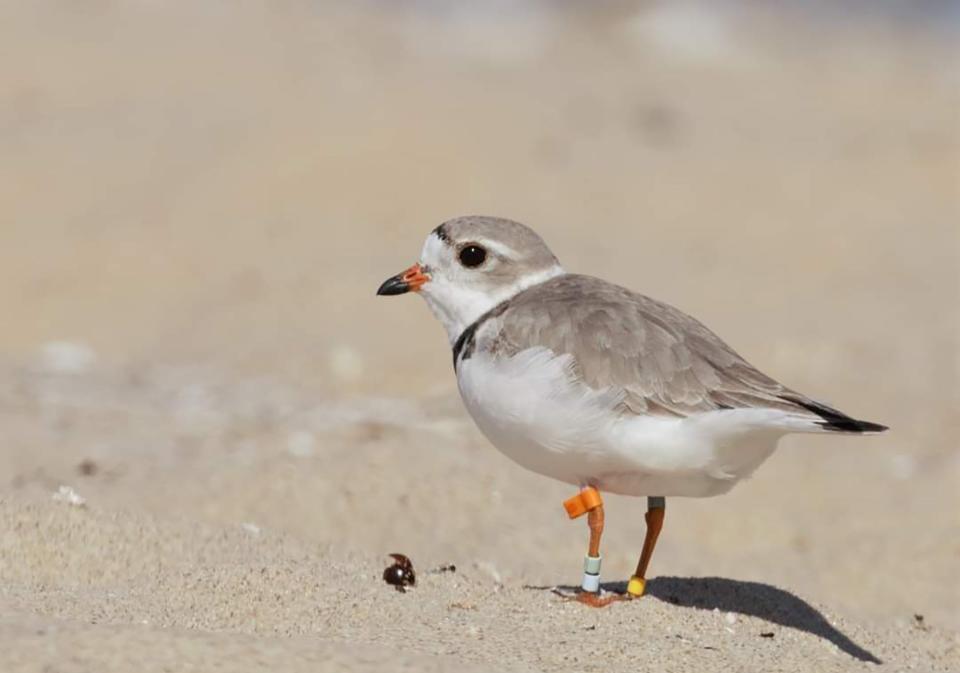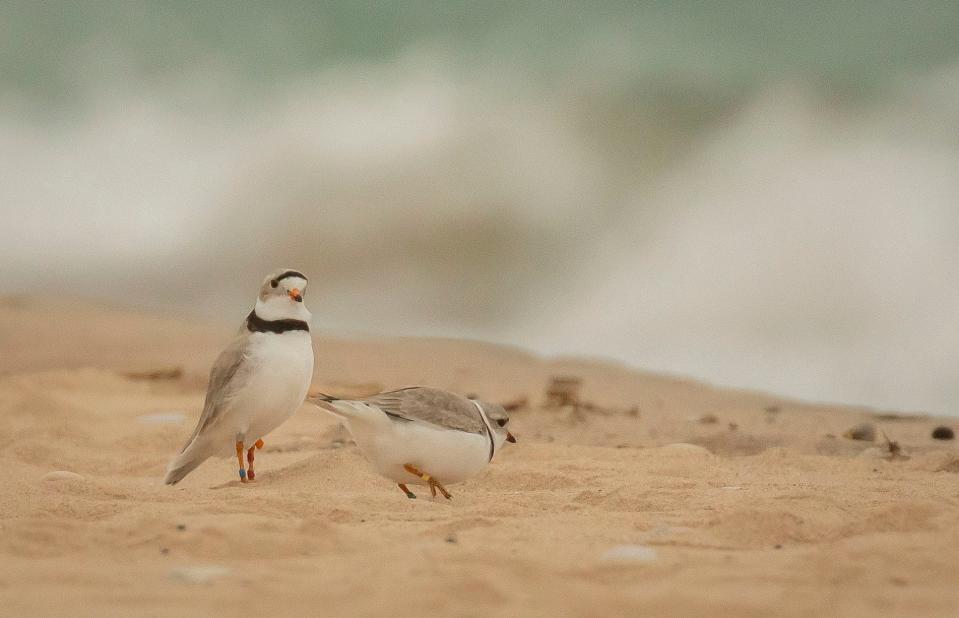Gabby, a 14-year-old bird, is crucial to survival of piping plovers in Michigan
At 14, Of,gb:X,Y — better known as Gabby — is the oldest living Great Lakes piping plover, an endangered, migratory bird that recently flew to the Sleeping Bear Dunes to reproduce. She is being tracked through an effort coordinated by the U.S. Fish and Wildlife Service.
Gabby's return to Michigan is "a huge relief," the Great Lakes Piping Plover Recovery team noted on social media.
As we approach Earth Day on Saturday, she shows us how such small, seemingly fragile creatures, can do remarkable things. Gabby goes between Michigan and Florida — sometimes in just a matter of days. She also reminds us just how vital it is to protect the planet.
The recovery group said more piping plovers will join her, an encouraging sign that the important bird species is gradually coming back from the brink of extinction.

"We are so honored to have such an experienced and smart elder female plover on our Great Lakes shores," the recovery group posted to Facebook earlier this week, adding that "soon enough it will be hard for us to monitor and keep track of all the exciting arrivals."
Gabby's longevity gives researchers hope for the species' survival and resilience as they seasonally migrate hundreds of miles and face all sorts of dangers, ranging from predators to beach trash. Throughout her life, she fledged 31 chicks, more birds to help propagate the species.
Why Gabby's survival matters
In many ways, environmental groups say, the survival of birds like Gabby, is also tied to the survival of humanity.
The Endangered Species Coalition makes the case: "When a species becomes endangered, it is a sign that the ecosystem is slowly falling apart. Each species that is lost triggers the loss of other species within its ecosystem. Humans depend on healthy ecosystems to purify our environment."
Plovers, for instance, help control the insect and small crustacean populations on beaches.
Ultimately, the coalition adds: "If we allow our environment to become contaminated, we risk our own health."
More: Piping plovers come to Sleeping Bear Dunes every year — and scientists are obsessed
More: Saginaw optometrist who threatened Starbucks' BLM supporters heads to prison
Gabby has lived a remarkable life, scientists say. She flies twice a year, some 1,500 miles each way, leaving Michigan for Florida after nesting and hatching fledglings, in late August and returning in April. Along the way, she has encountered all sorts of danger.
In fact, in the recovery group's Facebook post about Gabby, someone added a photo that was identified as Gabby from when "she was partially entangled on one leg and photographed" on Little Tiger Island, Florida, back in 2018. Attempts, the poster added, were made at the time to trap and free her, but "she eluded capture" and lived.
She is, the commenter observed, a "lucky, as well as, a resilient survivor."
Populations on the rise
Piping plovers have been historically rare in the Great Lakes basin, but their populations have dramatically increased in the past 30 years, according to the Smithsonian's Conservation Biology Institute, which is studying new threats to the birds by a small falcon, the merlin.
Piping plovers were listed as endangered in 1986, when there were fewer than 20 pairs of the sparrow-sized birds. By 2016, there were 75 breeding pairs of the species across the Great Lakes basin, an improvement, but hardly enough to deem the species saved, according to the recovery group tracking them.
And while most piping plovers breed in Michigan, some have also made love nests in Ohio, Wisconsin, Illinois, New York, Pennsylvania and Ontario, Canada. They winter in the South, having been spotted in North and South Carolina, Georgia, Florida, Alabama, Mississippi, Louisiana, Texas, and even other countries, the Bahamas, Mexico and Cuba.

Last year, the Free Press wrote about Vince Cavalieri, a wildlife biologist at Sleeping Bear Dunes who has spent a decade studying the Great Lakes piping plover — or its scientific name, Charadrius melodus — which is known to nest only along the Great Lakes and predominantly at Sleeping Bear Dunes National Lakeshore.
Cavalieri, who has had a life-long fascination with birds, noted Thursday that Gabby is the last bird tagged with a light green band, which is how she's tracked. Spotters see it, and call it in. He explained that her name, "Of,gb:X,Y," describes her unique band: Of = orange flag; gb = green and blue bands; X is a metal band, which has a number stamped on it; and Y is a yellow plastic band.
"Piping plovers are an umbrella species," he said. "By that, we mean, by protecting them — they are tied into the Great Lakes coastal dune system — we are protecting that entire ecosystem. If you preserve the piping plover, you are also helping to preserve other species."
Attachment to the birdies
Over time, researchers — and volunteer spotters — have become attached to the birds they are tracking.
A website, www.greatlakespipingplover.org, offers updates on the birds that are being tracked. Each one has a color-band, code and nickname. Many of the birds have been followed over years in various states through summers and winters.
The oldest tracked Great Lakes plover, BO:X,g or Old Man Plover, was 15.
He disappeared, and likely died, in 2018, a few years after he became crippled, losing the toes on his left foot, and leaving distinct peg marks in the sand, according to various accounts, including one from a blogger in Gloucester, Massachusetts.
This year, the recovery group noted in an April 10 post that the first piping plover had been spotted in the Great Lakes area, but asked: "Are there others we haven't heard about yet?" And it urged folks to keep an eye out for them, adding "our piping plover friends could be arriving and remain unseen for several weeks."
How to spot a piping plover
As scientists study ways to save the species, environmental groups are urging beach-goers to be vigilant.
Researchers from Michigan State University and the University of Minnesota have developed population models to show how controlling merlin and other nest predator populations could reduce the piping plover's risk of extinction, according to the Smithsonian.
Adult piping plovers have a black band across their foreheads from eye to eye, and a black stripe along the breast line and yellow-orange-red legs. The chest band is usually thicker in males during the breeding season and one way scientists tell the sexes apart.
The shorebirds nest and feed along coastal sand and gravel beaches, blending in with their habitat. They feast on insects, marine worms and crustaceans, and run in quick spurts. They also get the name "piping" from their bell-like whistles, which you can usually hear before you see them.

But as much as anything else, plover experts like Cavalieri say, you can help protect these tough little birds by being good environmental stewards, preserving their habitats, keeping your dogs from attacking them on the beach, and if you are out on any Great Lakes shoreline and spot one, by sending reports and photos to plover@umn.edu or glpipldata@gmail.com.
Contact Frank Witsil: 313-222-5022 or fwitsil@freepress.com.
This article originally appeared on Detroit Free Press: An elderly piping plover in Michigan is crucial to bird species

